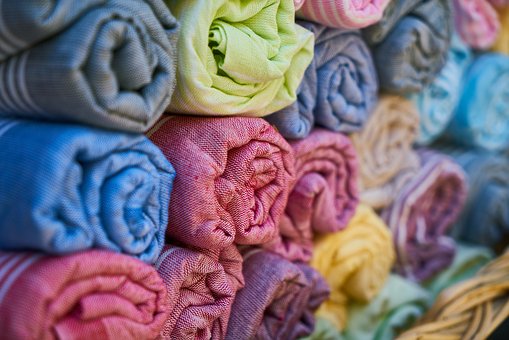Sarah Morrisroe graduated from the University of Southern California in May 2005, with a B.S. in Civil Engineering.
Billions of dollars are spent by consumers on hair care products every year, mostly on shampoo. Consumers are bombarded every day by advertising that promises stronger, shinier, healthier hair. Actually, differentiating additives, such as vitamins, account for small percentages of shampoo ingredients. The consumer may be shocked to hear that many advertised promises fall flat on the basis of science.
Introduction
Hair is an accessory that we all must wear everyday, on good days and on bad days. Appearance counts and studies have consistently shown that people feel more confident when they perceive their appearance is at its best. Knowing that beauty sells and money can be made, the hair care industry bombards us day in and day out with advertisements promising shinier, stronger, and volumized hair. The supermarket confronts consumers with hundreds of products. In 2002, consumers spent $1.3 billion on shampoos alone [1]. Shampoo manufacturers are trying to grab a share of the market by making their products unique: by promising the added benefit of vitamins or herbal extracts, companies lure consumers to specific products. A question the consumer should ask before shelling out ten dollars at the pharmacy for a shampoo is how many of these promises really make a difference and what effect do they have on hair?
Human Hair
Before examining the chemistry behind shampoos, some background information on the structure of human hair is necessary. The human hair consists of two main parts: the bulb, found underneath the skin and containing the root, and the shaft, which is above the skin surface and itself consists of many parts. The shaft has several concentric layers, starting from the medulla in the center, surrounded by the cortex, and finally the outer cuticle, made of keratin [2].
Since hair is made of dead cells that are no longer splitting, damage done cannot be repaired, only covered up. The cuticle, the scaly outer layer that protects the cortex, is extremely fragile and must be dealt with carefully. The cuticle can be thought of as stacked Styrofoam cups. When damaged or prone to damage, those cups will open out like a Christmas tree and can break off. Nowadays, companies formulate shampoo to minimize cuticle damage.
Shampoo Ingredients
All modern shampoos contain the same basic ingredients and are tailored to consumer desires. Consumers equate the foaming action, thickness of shampoo, and color of shampoo with cleaning power, even though they are not related. Shampoos contain a surfactant as the main cleansing ingredient that also provides foaming action. The two most commonly used primary surfactants are ammonium lauryl sulfate and sodium laureth sulfate [3]. To clean the hair, these surfactants make use of their hydrophilic (water-loving) and lipophilic (oil-loving) properties [4].
The most commonly used surfactants are anionics, which means they have a net negative charge. (Hair itself has a net negative charge). The oil soluble end of the surfactants surround the grease they encounter and the water-soluble part faces outwards. When rinsed, the net negative charge on the hair repels the negative charge of the surfactant and the dirt is rinsed away [5]. All shampoos on the market contain enough surfactant to more than adequately clean hair, meaning that it is the other chemicals that differentiate products.
Wet, freshly washed hair is very fragile and also negatively charged. Conditioning agents in shampoos, and also in separate cream rinse conditioners, utilize this charge differential to deposit cationic polymers on the hair. The positively charged conditioning agent is attracted and attaches to the negatively charged hair surface, remaining in place even during rinsing [4]. The conditioning agent will also contain a fatty group that, when attached to the hair, is responsible for the smoothness and shine [6,7]. The conditioner smoothes down the cuticle scales to make the hair softer and reduce static friction and charge. All shampoos contain some conditioning agent, even those that do not claim to be conditioning shampoos, as the consumer demands and expects soft hair.
The balance of shampoo is made up of foam boosters and stabilizers, preservatives, thickeners, fragrance, color, opacifying agents (responsible for the opaque, often pearlescent appearance), clarifying agents, pH control agents, and water [8]. The surfactants account for 8-20% of shampoo ingredients by weight, water accounts for 80-90%, and the remainder of ingredients are in very small percentages [6,7]. Marketing agents, which are the additives the consumer is most likely to hear about, typically account for less than 1% of the product. Product claims such as “rejuvenating”, “purifying”, “pH balanced”, and “adds vibrancy” are made to get consumers to buy products, but their actual effect is minimal (if anything). Ken Klein, a cosmetics researcher, states that these additives “are important to the overall picture/image of the shampoo and must be added even though science tells us that they have no function whatsoever” [7]. The vitamins and fruit extracts contained in many highly advertised shampoos and conditioners provide no tangible benefit to the hair.
Shampoo Properties
The four things that really do matter (cleansing, fragrance, viscosity, and foaming) are rarely thought of when advertising a product but are the most important to a consumer. Shampoos that do not foam well clean the hair just as well, but consumers do not feel this is the case. Likewise, shampoos that are thinner may actually condition one’s hair better, but thickness equals richness in the consumer’s mind [6].
Causes of Damaged Hair
Today’s shampoos have been designed with the consumer in mind. All consumers face the same challenges to their hair. From brushing to sun exposure, bleaching to hair spray build-up, the hair takes a beating. By the time hair length reaches one’s shoulders, it is estimated to already be 3 years old or more [5]. Combing and brushing hair sands down the protective cuticle layer and this effect is worsened when the hair is wet. Blow-drying hair removes the weakly bonded water, which weakens the hydrogen bonds in the hair’s protein. Sunlight and ultraviolet light break chemical bonds in the hair and studies have shown that the damage is proportional to intensity of sunlight and humidity. More humid environments invite more damage to the hair [9]. Damage to the hair is easily visible in a condition known as “split-ends.” This occurs at the end of a hair when the cuticle is so worn down that the cortex is exposed and then easily broken [2]. Damaged hair lacks the shine and body of new hair and is prone to frizz and flyaways. Because water accounts for up to 30% of hair composition, keeping hair moisturized is one key to healthy, shiny hair [10].
Conditioning Effects of Shampoo
Shampoo formulators confront the many sources of damage to hair and create products that mitigate the damages. One highly advertised shampoo quality today is “fortifying,” as seen in Garnier Fructis’ Fortifying Shampoo. A fortifying shampoo contains conditioning polymers such as Polyquaterniums 10 and 44. These cationic polymers are attracted to the negatively charged hair and neutralize it. The attraction lets the polymer serve like a cement-like paste that smoothes down the hair cuticle and holds the hair fiber in place [11]. The uncharged part of the polymer forms loops, which face out from the hair and reduce the friction between hair, leaving hair feeling conditioned and soft [12]. It must be noted that no shampoo, even fortifying shampoo, alters the properties of hair, such as elasticity and strength [5]. Shampoos can only provide a temporary fix to damaged hair.
Besides cationic polymers, several other ingredients can help manage hair. Emollients, consisting of oily materials such as dimethicone silicone which smoothes the hair by creating a thin film on the surface, add lubricity and slickness to hair. Dimethicone silicone is very hydrophobic and waterproofs the hair to minimize damage. Humectants also serve to condition the hair because they are hygroscopic, or water-absorbing. By promoting water retention, brittleness can be controlled in damaged hair. Two types of humectants frequently found in shampoos are glycerin and sorbitol. These are “polyols,” which are hydroxyl groups that attract and bind water [4].
Shampoo formulators also study extensively the location of damage and how to best attack it. The oil particles in conditioning agents that are left on the hair are responsible for lubricating and glossing the hair but will have a dulling effect over time if allowed to build-up. Shampoos that claim to remove build-up contain a strong surfactant that cleanses away the remnants of hair resins, found in hairspray, and conditioning agents to reveal the cuticle. Products that claim to moisturize the hair are often the cause of build-up as they are designed to deposit conditioning agents. New advances in shampoo formulation have led to the introduction of “weightless moisturizers,” such as Dove’s new line of shampoos, which involve using low molecular weight amino acids and fatty acids that are found in human hair. Together with traditional conditioning agents, they are found to not add noticeable weight to the human hair [10].
As the quest for their market share continues, shampoo manufacturers will continue to specialize hair care products to reach a target audience. As all of the 300+ commercially available shampoos on the market today will adequately clean hair, it is only the small percentage of differentiating additives that make products stand out [6]. A big question to consumers is will the more expensive shampoo really do enough for hair to justify the cost? Often the difference between budget and salon shampoos are the raw ingredients and their respective costs, such as the surfactants used. Suave has been very successful by marketing budget versions of pricier shampoos while promising comparable results. In 2002, Suave was the second best selling shampoo, with $42.2 million in sales [1]. As vanity is a hot commodity, consumers can find products as high-priced as they are willing to spend.
Shampoo Cost: To You the Consumer and to the Manufacturer
Because one of the biggest concerns of manufacturers is cost, it is generally a determining factor in formulation. The primary surfactant, the main cleansing ingredient, is often chosen based on cost. More expensive products such as sulfosuccinates, glutamate, and sarcosinates can cleanse and condition the hair better but they increase the raw material cost [6, 7]. The biggest reason that alkyl sulfates and alkyl ether sulfates are the primary surfactants in most shampoos is that they are less expensive [3]. Cheaper shampoos are typically made of cheaper ingredients, but it is not proven whether cheaper ingredients adversely affect your hair. Some surfactants are known to be milder than others, but the bottom line is that all will clean hair.
Measuring consumer reactions to aspects such as shine and softness is more of an act than a science. Shampoo manufacturers spend millions on research and development to make a product that satisfies consumer needs. While the promises made in advertisements are meant to increase sales, the claims made are not always valid. Despite all the conditioning benefits imaginable, the number one selling shampoo remains Clairol’s Herbal Essences, selling $93.6 million in 2002, more than double the sales of its closest competitor [1]. Herbal Essences represents a shampoo chosen for the pleasant fragrance and not for the conditioning benefits. Ultimately, consumers will decide what characteristics they desire in a shampoo and will choose the product that they perceive is best for them.
References
[1] V. MacDonald. “The Hair Care Market.” Happi, vol. 39.12, pp. 64-78, 2002.
[2] L.H.T. Tai. “Formulating Detergents and Personal Care Products: A Guide to Product Development.” Illinois: AOCS Press, 2000.
[3] J. Woodruff. “Formulators; It Is Time to Widen Your Horizons.” Chepstow: Society of Cosmetic Scientists, 2000.
[4] R. Schueller and P. Romanski. “Fundamentals of Formulating Hair Care Products.” Cosmetics & Toiletries Magazine, vol. 115.10, pp. 67-74, 2000.
[5] J. Gray. “The World of Hair.” Internet: http://www.pg.com/science/haircare/hair_twh_toc.htm, March 30, 2005.
[6] K. Klein. “Evaluating Shampoo Foam.” The Cosmetic Site. Allured Publishing Corporation. Internet: http://www.thecosmeticsite.com/formulating/haircare/1156956.html, March 29, 2005.
[7] “Shampoo Formulation: The Basics.” Cosmetics & Toiletries Magazine, vol, 119.5, pp. 64-68, 2004.
[8] R.R. Riso. “Shampoos & Conditioners.” Advances in Cosmetic Technology. Ed. Robert L. Goldemberg. New York: Harcourt Brace Jovanovich Inc., 1978.
[9] J. Gorman. “Chemistry of Colors and Curls.” Science News, vol. 160.8, pp. 124-126, 2001.
[10] M.I. Rendon, M. Wilson, et al. “Weightless Moisturization.” Cosmetics & Toiletries Magazine, vol. 119.6, 2004.
[11] P. Cotrell. “Telephone Interview.” March 30, 2005.
[12] Hossel, Dieing, et al. “Conditioning Polymers in Today’s Shampoo Formulations — Efficacy, Mechanism and Test Methods.” International Journal of Cosmetic Science, vol. 22.1, 2000.



